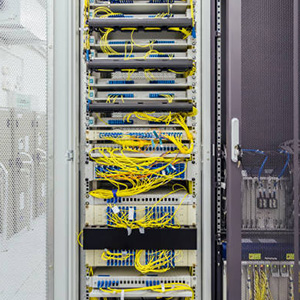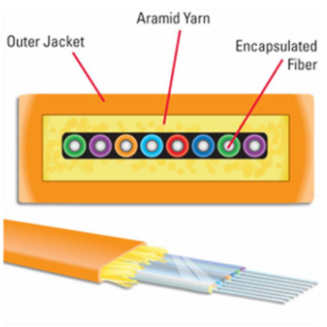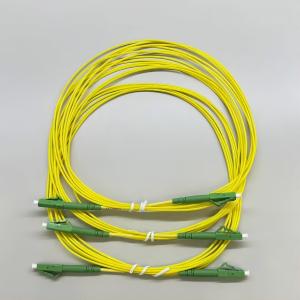With the leap in network technology, optical fiber has become a leader in the communications field due to its high-speed transmission and large-capacity characteristics. Optical fibers are mainly divided into single-mode and multi-mode. The two are very different in geometry and transmission characteristics, and their performance in actual applications is significantly different. This article will provide an in-depth analysis of the differences and applications between the two, helping you accurately select and use optical fiber to ensure efficient and stable network transmission.
The Basic Structural Difference Between Single-Mode Optical Fiber And Multi-Mode Optical Fiber
Outer Sheath Color Difference
The key to quickly distinguish single-mode and multi-mode optical fibers is to look at the outer sheath color. The TIA-598C standard stipulates that the yellow outer sheath identifies OS1/OS2 single-mode optical fibers, orange for OM1/OM2 multi-mode optical fibers, aqua for OM3/OM4 multi-mode optical fibers, and green outer sheaths for OM5 multi-mode optical fibers. Clear at a glance, efficient identification.
Difference In Core Diameter
The core diameter of single-mode fiber (SMF) is only 9μm, and it focuses on transmitting single-mode light of 1310nm, 1550nm and WDM wavelengths, so it has low dispersion and high bandwidth. In contrast, the core diameter of multi-mode fiber (MMF) is 50/62.5μm, and it can transmit multiple modes of light, but because of its many modes, the transmission constants and group rates are different, resulting in narrow bandwidth, large dispersion, and high loss. When choosing optical fiber, you need to weigh the characteristics of the two according to specific needs.

Differences In Light Sources
Due to the large core size of multimode fiber, some low-cost light sources like LEDs (light-emitting diodes) and VCSELs (vertical cavity surface-emitting lasers) that works at the 850nm and 1300nm wavelength are used in multimode fiber cables. While the single mode fiber often uses a laser or laser diodes to produce light injected into the cable.

The Difference In Transmission Distance Between Single-Mode Fiber And Multi-Mode Fiber
Single-mode fiber is good at long-distance transmission, while multimode fiber is suitable for short distances. Their transmission distances vary in different Ethernet rates, as shown in the following table.

Cost Differences Between Single-Mode Fiber And Multimode Fiber
The construction cost of multimode fiber optic systems is significantly higher than that of single-mode systems. The cost of a multi-mode transmission system (including optical modules and fiber optic patch cords) is approximately US$456-733, while a single-mode system costs over US$926. Choosing multimode optical fiber not only provides superior performance, but also achieves cost savings.
FAQs About Single-Mode Fiber And Multimode Fiber
Can Single-Mode Optical Fiber And Multi-Mode Optical Fiber Be Mixed And Used?
Single-mode optical fiber and multi-mode optical fiber cannot be directly connected due to the difference in transmission mode, otherwise it will easily lead to link loss and line jitter. However, with the help of single-to-multimode conversion jumper (mode adjustment jumper), it is easy to achieve seamless connection between single-mode and multi-mode links, ensuring efficient and stable transmission.
Can I Use Multimode Optical Modules On Single-Mode Fiber?
Single-mode optical fiber should not be used with multi-mode optical modules, otherwise the loss will be serious and even cause communication interruption. Single-mode optical fiber has a small diameter and multi-mode optical modules have a large light divergence angle. As the transmission distance increases, the signal attenuation increases and the signal may be lost before reaching the end point.
Can I Use Single-Mode Optical Modules On Multimode Fiber?
Multimode optical fiber is compatible with single-mode optical modules, but a fiber optic transceiver is required for conversion. For example, a 1000BASE-LX single-mode module can work on a multimode optical fiber through a transceiver. This converter also solves the connection problem between single-mode and multi-mode optical modules, achieving efficient communication.

How To Choose Single-Mode Fiber And Multi-Mode Fiber?
When choosing single-mode or multi-mode fiber, you need to weigh the transmission distance and cost. Within 550 meters, multi-mode fiber is economical and efficient; above several thousand meters, single-mode fiber is better and ensures stable transmission.
Summary
Single-mode fiber and multi-mode fiber each have their own characteristics: single-mode fiber dominates metropolitan area networks and PONs, while multi-mode fiber shines in enterprise networks and data centers. When choosing, just base it on actual wiring requirements to ensure efficient network operation.











